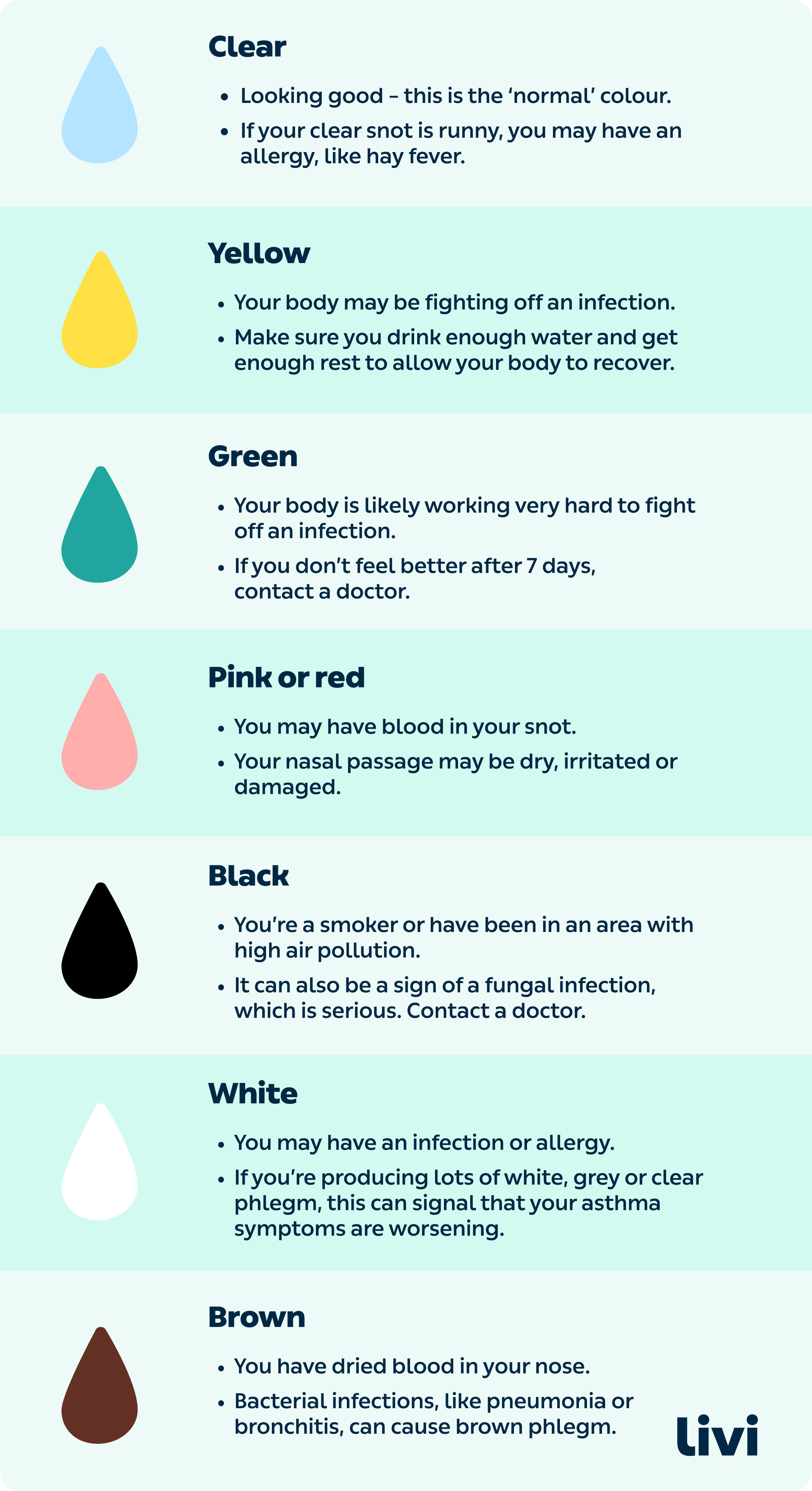If you’ve ever glanced at your tissue after blowing your nose, you may have noticed all sorts of colours and textures. In fact, the colour of your snot can give you some clues about your overall health.
So, what exactly is snot? Snot, the sticky substance that comes out of your nose during a cold, is just another term for mucus. Mucus is essentially a thick, jelly-like substance that lines your eyes, sinuses, nose, mouth, lungs and stomach.
Mucus plays a vital role in your body. It’s your body’s first line of defence in fighting infection because it contains antibodies, which trigger a reaction to ward off viruses and bacteria.

What do different snot colours mean?
1. Clear snot
Clear snot is generally considered the norm. Snot is mainly made up of water, but it also contains proteins and salts.
But clear snot that’s runny could be a sign of allergies, like hay fever, or even the start of a cold.
Hay fever is just one type of allergic rhinitis, which is inflammation of the inside of the nose caused by something you’re allergic to. Your immune system reacts to an allergen, such as mould, pollen, grass, dust mites or pet dander. Common symptoms include a runny or blocked nose, sneezing, and itchy watery red eyes.
If your symptoms are disrupting your sleep and everyday activities, speak to a doctor.
2. Yellow snot
Yellow snot is a sign that your body is probably fighting an infection. The yellow tinge comes from your white blood cells, which rush to the site of infection as an immune response to the infection.
It’s a good idea to make sure you’re drinking enough water and getting enough rest to allow your body to recover.
If your cold or infection is persistent and isn’t going away, a green or yellow discharge from the nose can also be a symptom of sinusitis. Other symptoms can include:
- A high temperature
- Pain, pressure and/or tenderness around your eyes, forehead or cheeks
- Bad breath
- Loss of smell
- Toothache
- A blocked nose
Speak to a doctor if your symptoms are severe, like an uncontrollable high temperature or bleeding from the nose, or if they haven’t improved after 7 days. You should also speak to them if you’re experiencing recurrent episodes of sinusitis.
3. Green snot
Have the contents of your nose turned green? Or are you coughing up green mucus? Thick green snot is also a common symptom when your body is working hard to fight off an infection.
The green colour comes from dead white blood cells that have been battling an infection, and other waste products being flushed out of your body.
If your symptoms continue to get worse or don’t get better after seven days, speak to a doctor.
4. Pink or red snot
Ever noticed pink or red mucus after blowing your nose? It’s usually no cause for alarm – blood in your snot typically means that your nasal passage is dry, irritated or damaged. This can occur with allergies or viral infections due to using nasal sprays or blowing your nose frequently.
You may also notice pink or red snot after a nosebleed.
5. Brown snot
Brown snot may be a result of dried blood that has been sitting in your nasal passage for a while. It could also be caused by inhaling something brown or red, such as dirt or smoke. For example, you may notice brown snot after walking around a busy city.
If you have regular nose bleeds and frequently see a lot of blood in your snot, speak to your doctor. If you notice that you’re coughing up brown or blood-stained phlegm, you should see a doctor because this can sometimes be an indicator of pneumonia or bronchitis.
6. Black snot
While you may notice that you have black snot if you smoke or are somewhere with heavy air pollution, it can also be a sign of a serious fungal infection.
Fungal infections can affect people who are immunocompromised, so it’s important to speak to a doctor.
7. White snot
Have you ever noticed that your snot is white when you’re feeling congested? White snot can be a sign of a cold, nasal infection or allergy. When your nasal passage gets inflamed, your snot loses its water content and moisture – making it cloudy and thick.
You may also experience other accompanying symptoms, like coughing, congestion, a high temperature or a sore throat.
If you have asthma and are producing lots of white, grey or clear phlegm, it could be an indication that your airways are inflamed and your asthma symptoms are getting worse.
When to contact a doctor
You should make an appointment to speak to a doctor if:
- Your symptoms are not improving after 7 days
- You have a persistently high temperature
- You have very dark, thick or bloodstained mucus
- You have been coughing for 3 weeks or more
If you’re having difficulty breathing, go to A&E immediately.
This article has been medically reviewed by Dr Bryony Henderson, Lead GP at Livi.



